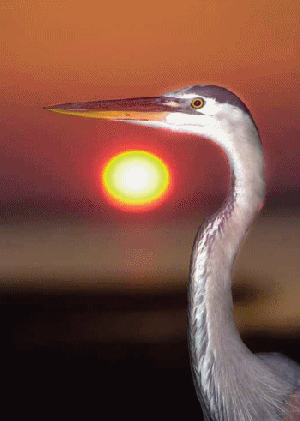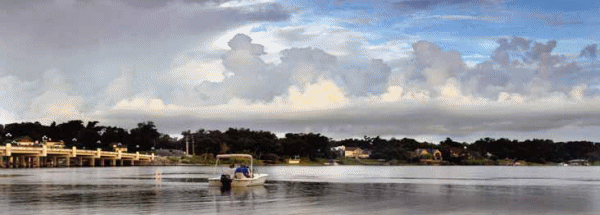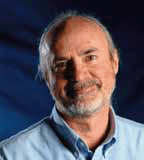SEJournal Online is the digital news magazine of the Society of Environmental Journalists. Learn more about SEJournal Online, including submission, subscription and advertising information.
By SUSAN FEATHERS
 |
| A great blue heron known locally as Gus surveys his surroundings as the sun sets over Pensacola, Fla. © Photo by Michael Spooneybarger, Pensacola News Journal. |
"We’re condemned to the past. That’s the clearest lesson for me from our editorial series on the environment, which concludes today. This area’s most serious environmental problems stem from ignorant errors of commission long ago, or modern errors of omission — failure to do the right thing when we realized how severely we were fouling our own nest.”
Delivering such sobering conclusions to a community without rendering them hopeless is not an easy task. That was the challenge that Carl Wernicke, opinion editor at the Pensacola News Journal, recently faced.
Assigned by the executive editor to prepare an editorial series on the 10-year anniversary of a grand jury investigation into air and water polluters, Wernicke began research into whether Pensacola’s air and water had become any cleaner since the 1999 grand jury had found Pensacola’s air a threat to residents and its water dangerously polluted.
A long-time community member and career journalist with the News Journal, Wernicke suspected the outcome would not be pretty — or at best, unclear.
While industry has done much to clean up air emissions, more cars on the road have increased ozone-causing air pollution in Pensacola.
The grand jury had essentially asked a basic question: “What is the quality of the area’s air and water?”
Wernicke concluded that 10 years later officials still can’t give a consistent answer. As he met with experts it became clear that even though much data aimed at answering the question is being collected, the effort is not well coordinated and investing the considerable funds necessary to find the answer is still an obstacle.
What were some of the secrets to Wernicke’s quest?
“Exhaustive research,” Wernicke said, “letting the science take the lead, decades of building trust among my sources, and [when it came time to do the writing] simply letting the cards talk.”
Pensacola has a long, rich history of bountiful, beautiful natural resources. Industry, though, saw it as opportunity.
 |
|
Ten years after a special grand jury on air and water in Pensacola, Fla. found its waters polluted by “foul stormwater runoff, plants dumping treated wastewater directly into bayous and bays, and ‘not much hope for change,’” a pleasure craft motors out of Bayou Texar toward Pensacola’s Escambia Bay as the sun rises and a light shower begins to fall. © Photo by Tony Giberson, Pensacola News Journal.
|
Five nations’ flags have flown over the white crystal beaches and aquamarine waters of this old city with its expansive bay — a natural deep-water port that drew armies from Spain, France, Britain, the Confederacy and eventually the U.S. Navy.
Stands of towering live oaks and long leafed pines supported shipbuilding, logging and turpentine industries. Gulf waters, rivers and estuaries supported a major fishing industry. Railroads and ships carried products far and wide. As those industries waned, chemical industries replaced them. While each contributed to the economic base, each left behind lethal footprints: creosote, pentachlorophenol, dioxin, fluoride, arsenic, lead and radium 226/228, volatile organic compounds, polycyclic aromatic hydrocarbons and PCP. These became an unwelcome local product — three Superfund sites. Like so many municipalities that have attracted industry to support their economy, Pensacola residents were left with the burden of clean-up after the industry left town.
The Special Grand Jury on Air & Water in 1999 found “Pensacola’s bays and bayous polluted, air quality that harmed the people who breathed it. Superfund sites that polluted wells and groundwater, foul stormwater runoff, plants dumping treated wastewater directly into bayous and bays and ‘not much hope for change.’”
The News Journal’s executive editor, Dick Schneider, thought a 10-year anniversary warranted coverage. Wernicke, who was the opinion page editor at the time of the original grand jury report, was assigned the task of sorting out what progress had occurred since the grand jury found much to criticize in 1999.
“I was given an unprecedented two months to focus entirely on the series,” Wernicke said. “In my time on the paper I don’t remember any story that got that much time.”
Wernicke was given more time later to follow up on controversial or complex issues and to polish the articles. “We didn’t actually develop the story budget until much of the research was done because we wanted the research to drive the series, not a preconceived view,” he said.
Discussions about how the information should be published ranged from an in-depth, detailed article (“brain numbing”) to five consecutive days (“beating readers over the head”) to the final format: a series of five consecutive Sunday editions with a short introduction on the front page continued on the opinion page.
“Our thought was that some people who would not read an entire page of reporting on the environment might at least read the introduction where we summarized the results on the series topic,” Wernicke said.
Wernicke kept in mind while writing that it was best to appeal to basic interests like parents worried about their kids’ health or fishermen worried about whether they can consume their catch.
“Over the last decade I’ve noticed that people get involved when it affects them directly, so for example more fishermen are getting active in environmental issues now that certain fish [mullet] can no longer be eaten because of PCB or toxic metal contamination,” he said. “I appeal to those interests as well as to parents of kids whose health could be impacted by water and air quality.” An example from Wernicke’s piece focused on water pollution:
“Mercury is found in a wide variety of saltwater fish in coastal waters across Florida, including here. In an ironic, and sad, commentary the Escambia Health Department has billboards encouraging pregnant women to eat fish low in mercury. Of the five fish recommended, none is caught locally.”
Wernicke dealt not only with critical water issues, but he also identified the most important issues to tackle first, helping readers sort through the material. For example, Wernicke highlighted stormwater pollution as “the biggest and toughest problem.”
Then he illustrated how to go about solving it using information from experts: 1) capture runoff at its source rather than treating it later; 2) institute sustainable growth management rules (low impact development).
Living and reporting for decades in the community helped Wernicke greatly.
“All my sources are well known to me, having written about the issues in Pensacola over three decades — long enough to develop trust with each source,” he said. “They’ve learned over time I’m not going to come back on them when they have talked off the record in an attempt to help me grasp the issues entirely. I’ve tried over the years to act responsibly while still striving for transparency in reporting.”
From such relationships, Wernicke said, he has been able “to gain a solid ground on the issues where another reporter might have the door shut on him.”
“Listening to my sources and following the issues from their perspective,” he added, “is not only very rewarding but opened up new avenues of investigation we had not thought to cover.”
Some problems have emerged since that grand jury met a decade ago. For example, Wernicke detailed the growing concern nationally over the threat of pharmaceutical remnants and other chemicals from personal care products in both drinking water and surface waters, coming primarily from sewage treatment plant discharges.
“Since a number of local sewage plants discharge into our bays and rivers, and none of those plants uses treatment systems that remove these chemicals, that seems like a likely concern for this area,” Wernicke said. “This is an area we will follow more closely based on the interviews.”
Tackling the last editorial — “Who’s looking out for our air and water?” — presented a challenge with so many agencies responsible for the same resource. “I chose one creek — Carpenter’s Creek — which runs across city, county and state governance boundaries to illustrate how everyone — and no one — is truly in charge of our stormwater management,” Wernicke said.
“An editorial series based on voluminous, often conflicting data, and not very encouraging realities, is tricky: you want to give people the truth but at the same time you can’t leave them hopeless,” he said. “So I concentrated on the most critical data (sources helped me identify these), organized it into concise sections. Then, we laid out what citizens can do on a personal and community level to begin working toward a cleaner environment in 2019.”
After publication, Wernicke grew worried. At first, there was only silence.
“At first it was so quiet we worried we had not reported strongly enough,” he recalled. Florida regulators “had expressed concerns about the direction of the reporting when I first contacted them. After the series was published no comments were forthcoming. Was it because we did it well, that we gave credit where credit was due? I tried to be fair but truthful.”
But response came. A retired Florida Supreme Court justice soon recommended the formation of a new environmental task force to further study the issues as part of an effort to consolidate city and county government.
The News Journal, which is owned by Gannett, is following the Florida offshore drilling hearings this year. Tallahassee, Pensacola, Ft. Myers, and Melbourne papers will provide coverage. And the News Journal is planning on more coverage, especially of this new issue of pharmaceuticals in the water supply.
The Journalist:
 |
|
Pensacola News Journal Opinion Editor, Carl Wernicke. © Photo by Ben Twingley, Pensacola News Journal.
|
Carl Wernicke graduated from University of Florida’s School of Journalism. He began his career at the Press-Register in Mobile, Ala. as a rookie reporter for three years. He joined the Pensacola News Journal in 1978 and has since covered all areas of the news room. He is currently the Opinion Editor, pinchhitting as an environmental reporter since the loss of a full-time environmental reporter position.
Wernicke notes the loss of a full-time environmental reporter as regrettable for an area where so many environmental issues are developing. “Elizabeth Bluemink, an SEJ member, was our last full-time environmental reporter. She was a great asset.”
“My interest in writing about the environment grew over time as I became more educated about issues and the science behind it. Today my wife and I are environmentally motivated citizens. We have taken responsibility for trash removal from a stretch of road near our property and steward our land. Over time, interviewing local scientists and knowledgeable citizens, I’ve become confident reporting on our local environmental issues.”
Not a “24/7 journalist,” Wernicke recommends going home at night and enjoying the weekends — “Live a normal life!” He can be contacted at cwernicke@pnj.com
Susan Feathers is a freelance writer living in Pensacola, Fla.
Sources Used by Wernicke
|
**From the quarterly newsletter SEJournal, Winter 2009-10 issue.










 Advertisement
Advertisement 


